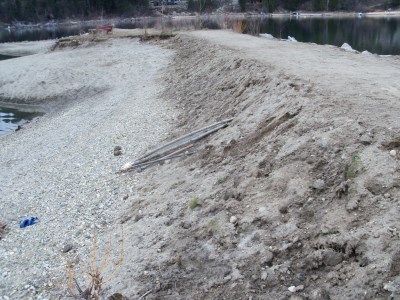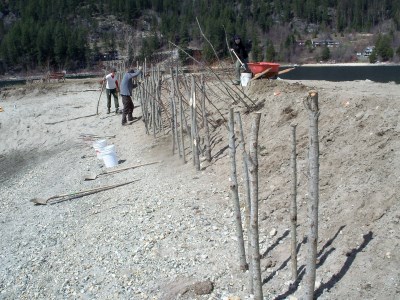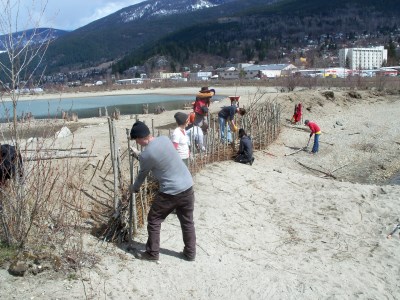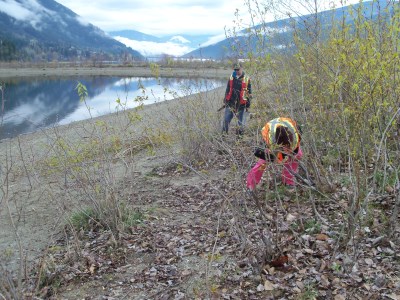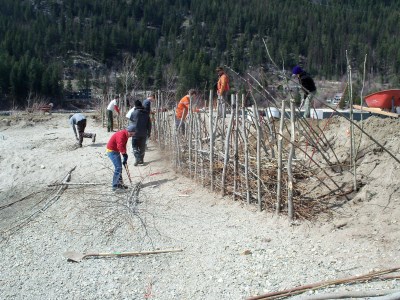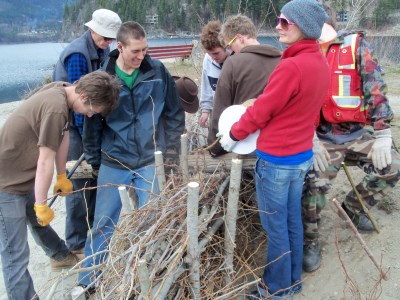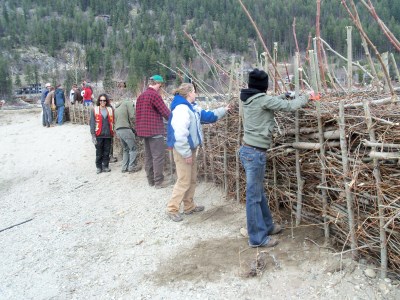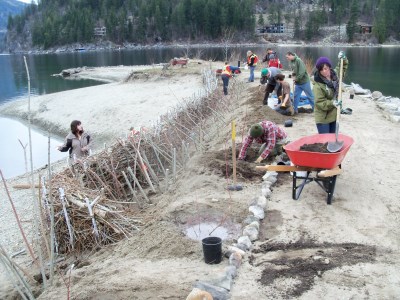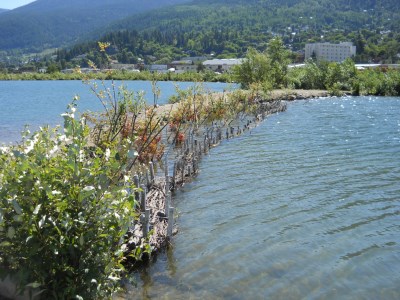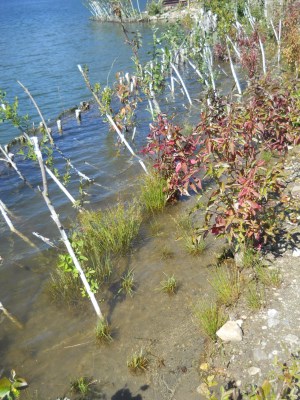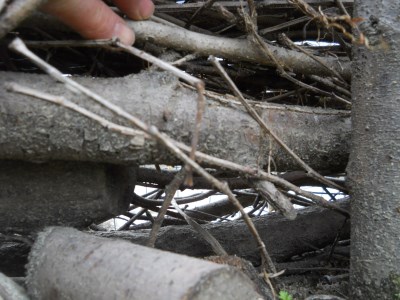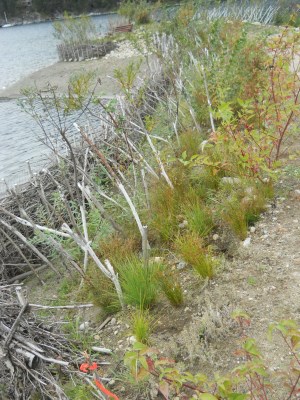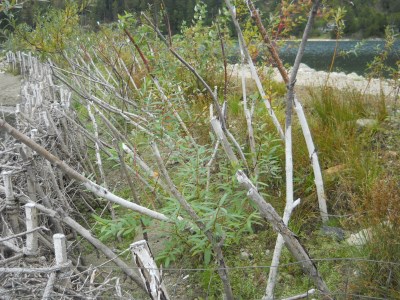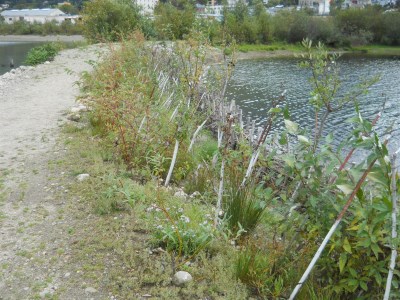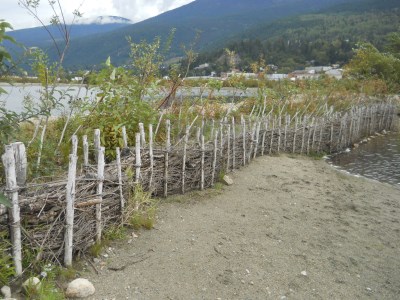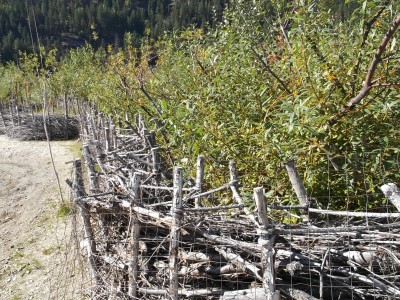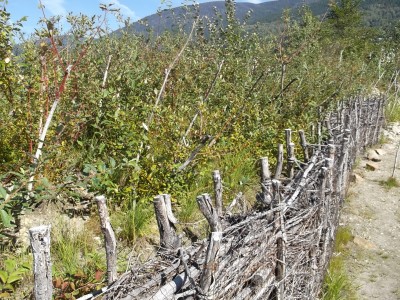Prior to this multi-year project wave-induced erosion of the higher banks during peak water periods was causing rapid loss of this peninsula. One of the techniques used here to control this erosion was the construction of Branch Box Breakwaters (called “Breakwaters” below). This method has been used elsewhere (in the US), and was discovered through on-line research.
Breakwater structures, ideally constructed from locally available materials, provide effective protection for several years, slowing bank erosion greatly and allowing riparian vegetation to establish. Each year from 2011 to 2015 a new breakwater structure was constructed on the peninsula.
These structures can be divided into three categories — note: construction of the 2011 Breakwater (not back-filled) is described below; the same general procedure is used for all three categories:
- Breakwaters (not back-filled): These are constructed to shield banks from wave impact and therefore slow rapid soil erosion. Vegetation establishes readily (planted or natural regeneration) in the protected area behind the structure. Here the breakwater can be constructed further out from the bank providing a larger protected area. The sheltered area also provides excellent habitat for small fish when flooded. See below.
- Breakwaters (back-filled): These are constructed immediately in front of sensitive banks and are then lined with biodegradable matting and back-filled with soil (preferably organic-rich material) to rebuild the bank. Vegetation is planted into this fill material. See Breakwaters (back-filled) for instructions.
- Sand Bar Breakwaters: These are constructed to protect low gradient areas (e.g., sand bars) from wave-induced turbation during shallow water periods. Here the wave energy is not causing erosion of the bar, but rather prevents the establishment of plants. The sheltered area also provides excellent habitat for small fish when flooded. See Sand Bar Breakwaters for instructions.
2011 Breakwater (not back-filled):
The 2011 Breakwater was the first breakwater structure constructed on the peninsula. This has been very effective at creating a sheltered environment for willows, dogwood and sedges to establish. The photos below illustrate the construction process.
Late April 2011
The straight section of bank beginning in the foreground is where the 2011 Breakwater was built. This bank was highly susceptible to wave-induced erosion during peak flood periods.
The first step in constructing this breakwater was to pound in a double row of posts at the toe of the bank (see note below).
The posts in each row are spaced about 40 cm apart, and the space between the rows is about 30-40 cm. The posts here are locally collected Scouler’s willow, an upland willow species with generally very straight stems and very hard wood (these did not take root and grown here). Cottonwood could also be used (which likely would take root). Posts can also be fashioned from a number of other species, including young conifer trees.
The top of the posts should be as high or slightly higher than the top of the bank you wish to protect. The posts were first sharpened with an ax, and then a pilot hole was made with a digging bar before pounding each of them in.
Note: In retrospect this structure could have been placed further out from the toe of the bank. This would have created a wider band of stabilizing vegetation with only minimal addition breakwater height required.
Full stem lengths of young cottonwood were then tightly packed into the space between the posts to form a wall. Stand on the biomass to pack it well, or place a log or board across and press drown at both ends.
The biomass from a number of other deciduous trees or shrubs could also be used, such as willow, alder, birch etc.
At this site there is dense growth of young cottonwood trees along the nearby footpath, which was cut manually with loppers and dragged over to the peninsula.
See note below.
Note: A considerable amount of vegetation biomass is required to fill the breakwater wall. The constructing these structures is therefore suited to projects with substantial input from volunteers.
Placing the cottonwood biomass inside the structure.
The cottonwood biomass was tied down with biodegradable 1/2″ manila rope when the wall was half-way filled, and again when completely filled. The rope was crisscrossed over and tied to each post using clove-hitches (see header image above). Note the use of a log to press the biomass down here.
The breakwater is nearly completed here. Note that the top of the structure is the same height as the top of the bank.
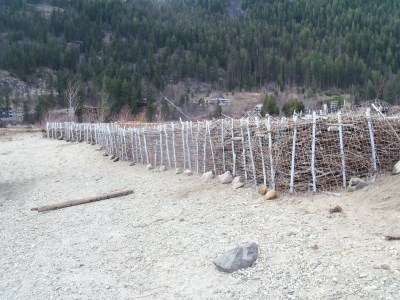 Completed structure.
Completed structure.
Completed structure. Stucco wire was installed in front to prevent damage by beaver that inhabit this area.
Other than this wire the structure is 100% biodegradable.
Rooted and unrooted cuttings of Sitka willow and Red-osier dogwood were planted behind the structure, as well as Lakeshore sedge.
July 2013
This shows the structure with the lake level at 533 m (Fortis BC data). This is a fairly normal maximum yearly lake level here.
Small fish seen swimming in the protected area behind the structure. Such breakwaters provide young fish with feeding and refuge habitat.
Fish gain access to the area behind the structure through numerous openings in wall.
September 2013
September 2015
The structure is still solid here and is expected to last for several more years.
Excellent growth of sedges behind the structure is seen here.

